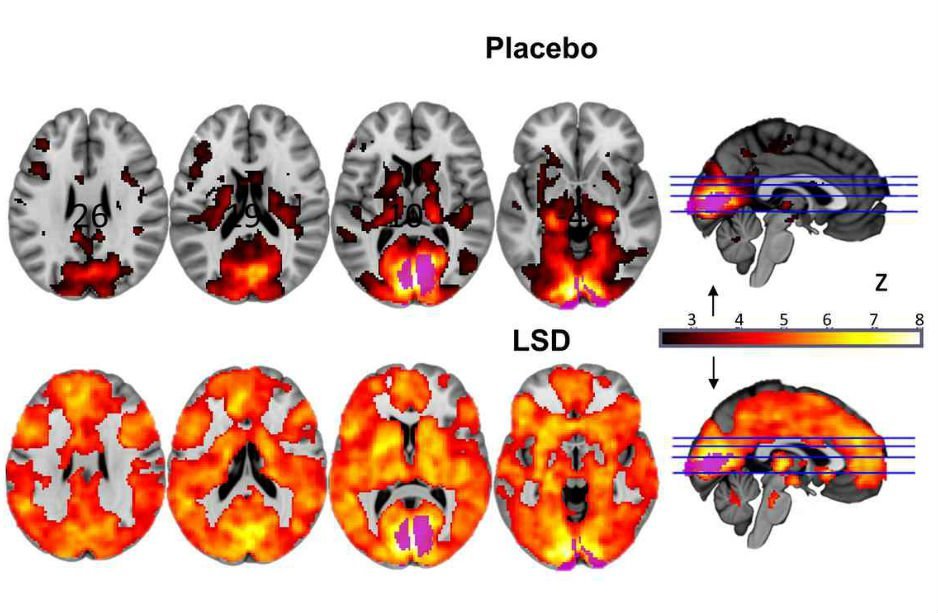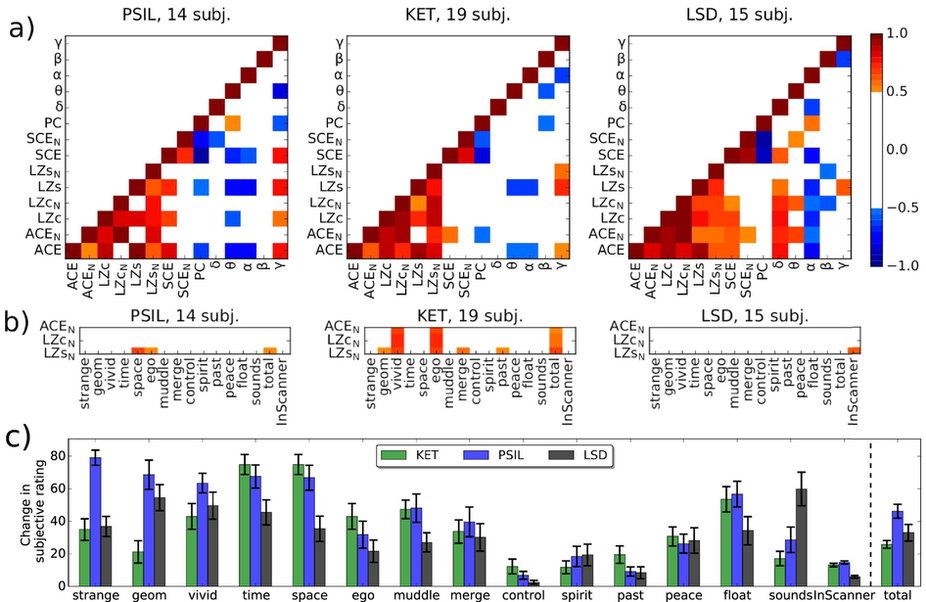Received the first scientific evidence of "higher level of consciousness"

Average changes in the level of complexity of brain activity according to the Lempel – Ziv algorithm over one channel (this is only one of several measurable mathematical metrics of signal complexity) for three psychotropic drugs: psilocybin, ketamine and LSD. Red color corresponds to an increase in difficulty. Image: University of Sussex
Understanding the neurological basis of consciousness is one of the most difficult puzzles facing modern science. The wording of "consciousness" therefore varies from extremely broad to extremely narrow, but on an intuitive level, everyone understands that there is a difference between the level of consciousness (to what extent a person is conscious) and the content of consciousness (thoughts, sensations, feelings). Accordingly, most neurological studies study these two dimensions separately. According to brain activity, it is much easier to establish the difference between levels of consciousness - brain activity in an unconscious person and in a person in consciousness is clearly visible. Formally, this is expressed through the index of diversity of neural signals - a mathematical characteristic of the level of consciousness.
It would seem that the difference between the levels is clearly established and documented. But in the results of magnetic encephalography, scientists from the Sackler Center for the Study of Consciousness at the University of Sussex (United Kingdom) found very strong and sustained bursts of diversity of neural signals in the brain of patients after taking psychoactive doses of certain drugs: ketamine, LSD and psilocybin. The complexity of brain activity during these surges in people is much higher than at the normal level of consciousness. The scientific work was published on April 19, 2017 in the journal Scientific Reports (doi: 10.1038 / srep46421).
Scientists registered enhanced activity of the brain under the influence of psychotropic drugs even earlier, although in most countries such experiments are difficult due to legal restrictions on the use of psychotropic drugs. But in the UK, scientists managed to get permission. A year ago, a group from Imperial College London published the first detailed brain scans, which are under the influence of LSD . It was found that in this state the connection of the visual cortex with other areas significantly increases. In other words, after taking LSD, the processing of visual information in the brain is no longer limited to the visual cortex. All areas of the brain begin to participate in the formation of visual images in patients. This is especially interesting given the fact that during the experience the patients' eyes were closed. That is, in fact, patients began to "see with their eyes closed."
')

In the current experience, scientists have gone even further - and focused on the quantitative measurement of the level of consciousness, that is, the mathematical index of the diversity of neural signals. For the analysis, they took data from three previous experiments, including those published a year ago by colleagues from Imperial College London. As expected, in an overactive state, the brain exhibits an unusually complex activity that is much higher than that in a “normal” conscious state. The difference between these two indicators is about the same as the difference in consciousness in a waking and sleeping person. This gives reason to talk about the third, higher level of consciousness, which is higher than wakefulness as much as wakefulness is higher than sleep. On the Neuroscience News website dedicated to neuroscience news, this discovery was called "the first evidence of a higher state of consciousness." But with the proviso that only in this particular mathematical metric.
The authors of the scientific work say that additional experiments are required to confirm these results, but express “restrained admiration” with what they saw on the results of magnetic encephalography: “In the psychedelic state, the brain electrical activity is less predictable and less“ integrated ”than in the normal conscious state of wakefulness how it measures the total diversity of neural signals. - says Professor Anil Seth (Anil Seth), co-author of scientific work. “Since this metric has already shown its value as an indicator of the“ level of consciousness ”, we can speak of the psychedelic state of consciousness as a higher“ level of consciousness ”than the normal level, but only in relation to this particular mathematical metric.”
Another interesting fact is that in the brain activity from all three drugs similar changes occur, but with varying degrees of intensity.

The illustration in the upper row shows the magnitude of the Pearson correlation coefficients for patients who took the drugs, compared with patients who took a placebo, according to different metrics. In the bottom row - the average difference when answering questions on different topics.
Scientists emphasize that measurement results do not give grounds to believe that a more active state of consciousness is “better” or “preferable” than a normal state. But these data allow us to understand what is happening in the patient's brain under the influence of psychotropic drugs. Scientists hope that the results of the study will be an argument for the authorities to allow the testing of these powerful substances for the treatment of clinical depression under strict medical supervision. They believe that only under observation can one predict the positive effect of such treatment.
Source: https://habr.com/ru/post/403357/
All Articles